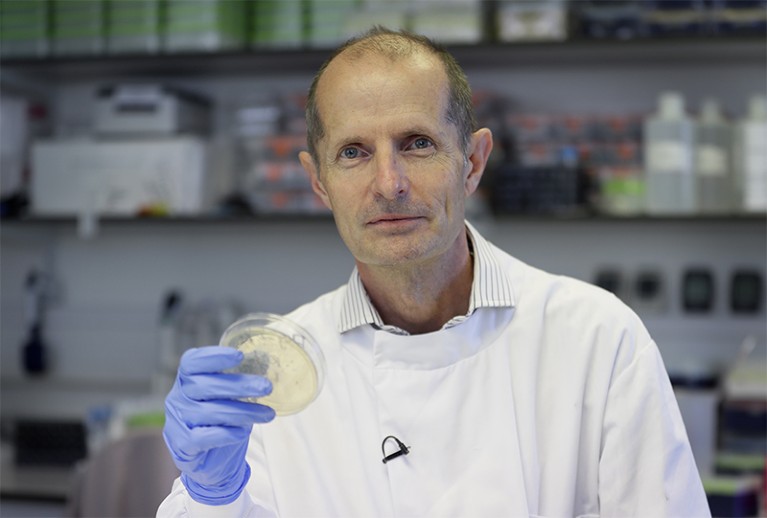
Robin ShattockCredit: Kirsty Wigglesworth/AP/Shutterstock
Robin Shattock is head of immunology and infection in the Department of Infectious Disease at Imperial College London. He speaks to Nature about the field of vaccine science, and how researchers can start working in it.
What is working in vaccine science like at present?
It’s an incredibly exciting time. During the 1960s, vaccines against some devastating diseases such as polio, measles, mumps and rubella were being developed. Since then, finding innovative approaches has been more difficult.
I’ve spent 30 years working on HIV, and we’re still struggling to design an effective vaccine for it. Now, new vaccine technologies, particularly those based on RNA, are driving a renaissance in interest and investment. I think some of the advances made in response to COVID-19 will help against HIV and other difficult targets.
Which aspects of vaccine development are you focused on?
Our main work streams are in the early discovery phase. We’re trying to better understand which messenger RNAs to include to produce the proteins we want, working across a range of disease areas, including rabies, Ebola, lassa fever and Marburg virus disease. We’re trying to work out the best way to deliver RNA and to get it to work effectively, while also thinking about scale-up and manufacturing.
Part of Nature Career Guide: Vaccines
Most recently, I’ve been very excited about technology for producing what are known as self-amplifying RNA (saRNA) vaccines. Our candidate saRNA COVID-19 vaccine delivers the genetic instructions to cells to make both the SARS-CoV-2 spike protein and an enzyme that copies those instructions. The aim is to achieve longer-lasting immunity with less vaccine. We’ve shown that it has a good immune response and safety profile. We are now making modifications to strengthen the immune response.
Apart from COVID-19, what conditions are RNA vaccines likely to be effective against?
The technology can help to accelerate research against some really hard infectious-disease targets, such as HIV, tuberculosis and malaria. We think it will be highly relevant in responses to other pandemics. It can be applied to protein replacement therapy, for example, and to a range of non-infectious diseases. Research on its use in cancer vaccines will accelerate.
We hope that it will also be possible to produce small batches of RNA vaccines, allowing the targeting of diseases that are not currently commercially viable to target.
What impact has COVID-19 had on scientists working on vaccines?
There has been an increase in the public profile of scientists, and people have been very supportive.
The pandemic has also changed the speed at which people think vaccines can be developed. RNA technology will accelerate the ability to do early clinical trials to understand human immune responses. But there is a danger that people will think that because vaccines against COVID-19 have been developed so quickly, there are going to be successes in all areas. In fact, COVID-19 was, in some ways, an easier target than other infections, because of previous work on coronaviruses. So it’s an exciting time for vaccine development, but the raised levels of expectation bring their own challenges.
What advice would you give to early-career researchers inspired to work on vaccines?
They must be driven by scientific inquiry. If their early interest in the science itself is not strong enough, it isn’t going to be sustained over the longer term. They need to be flexible and resilient, and be aware that there are more failures than successes in this line of work. They also need to have realistic expectations. It’s unlikely that somebody is going to develop a vaccine from scratch in their PhD.
Are there particular skills that they should seek?
Vaccine science is very broad, and encompasses a lot of skill sets. Some people might be better at doing the early innovation; others might have the skills needed to work out how to scale up vaccines, or get to grips with process innovation or programmatic management.
The chain from early discovery to having something in a vial that can be commercialized and is globally relevant requires a whole team. There’s a tendency to focus on individuals, but success is likely to demand long-term work as part of a team.
What are some of the key future challenges?
Until COVID-19, nobody was making a global RNA vaccine, so capacity had to be built almost overnight. To guard against future pandemics, we need manufacturing hubs around the world so that things can swing into action much more quickly.
We also need to make RNA vaccines that are more thermally stable; that way, they’d be more amenable for global roll-out, particularly in low- and middle-income countries. At Imperial, we have formulations that are stable at refrigeration temperatures for many months. And we’re not alone, so I think that challenge will be solved quite soon. Like others, we’re also working on freeze-dried vaccines that can sit on the shelf at room temperature for years.
Looking at how vaccines can play a part in combating antibiotic resistance will also become increasingly important.

 A guide on how to work in vaccine science
A guide on how to work in vaccine science
 Lessons learnt from doing research amid a humanitarian crisis
Lessons learnt from doing research amid a humanitarian crisis
 The tangled history of mRNA vaccines
The tangled history of mRNA vaccines








